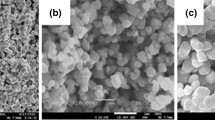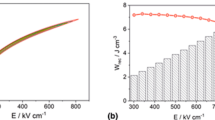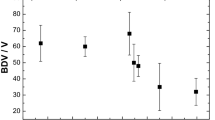Abstract
Ni-BaTiO3 multilayer ceramic capacitors (MLCC) have been aged at 121 °C and 100% Relative Humidity for 2,600 h. Raman and energy dispersive spectral measurements have been made on both aged and unaged samples. Raman spectra indicate the presence of a coating of substoichiometric SnO x (1 < x < 2) in the aged samples. Morphological and elemental changes occurring in the MLCC were examined by Scanning Electron Microscopy (SEM) and Energy Dispersive Spectroscopy (EDS). Preliminary, frequency dependent dielectric measurements indicate that ageing causes a substantial decrease (about 50%) of the capacitance, even if only surfaces are affected by the ageing phenomenon.
Similar content being viewed by others
Explore related subjects
Discover the latest articles, news and stories from top researchers in related subjects.Avoid common mistakes on your manuscript.
Introduction
Since the discovery of ferroelectricity in barium titanate (BaTiO3) in the 1940s [1], much research has been carried out on this ceramic material, because of its high dielectric constant. Nowadays, multilayer ceramic capacitors (MLCCs) based on BaTiO3 are one of the most important electronic components in surface mounted electronic circuits [2]. MLCCs consist of alternate thin dielectric layers and internal electrode layers in one body, and both ends are terminated by external electrodes. While precious metals, especially Pd, have been conventionally used as the electrode material, MLCCs that use Ni, a base metal, for the internal electrode, have been successfully developed to meet the growing need for low cost capacitors, while maintaining device performance [3]. It has been shown that barium titanate shows dielectric ageing [4]. The spontaneous, undesired changes of the electric properties of functional ceramics as a function of time/temperature are usually referred to as ageing phenomena [4]. In early studies on ferroelectric materials, these effects were attributed to a stress-induced relaxation of the ferroelectric domain structure to a more stable state [5, 6]. Spontaneous polarization is believed to play an important role in the phenomenon. When an electric field is applied, polarization persists even after the removal of the electric field, causing a decrease in the dielectric constant [7]. It is believed that the high firing or annealing temperature might introduce cation vacancies, which can easily move under electric field, causing crystallographic anisotropy, and then a decrease of the mobility of the domain walls [7]. Not much is known in the literature about the effect of ageing of the Ni-BaTiO3 MLCC capacitor under severe environmental conditions. A recent investigation of an intentional degrading of Ni-BaTiO3 multilayer capacitor under controlled oxygen environment reported that the degradation observed was due to the clustering or accumulation of oxygen vacancies in the structural framework of BaTiO3, which gives rise to the formation of new metastable structures, in which a reduction in the valence state of the Ti cations were deduced [8]. In these studies the common denominator is the focus on structural changes in the BaTiO3, which then influence the functional behavior of the device. Albeit severe environmental conditions are hardly encountered in standard circuitry, these same perovskite structures are used also as sensors and actuators, and in these latter applications the environment surrounding the device is far less controllable. It is within this frame that the ageing experiments of Ni-BaTiO3 MLCC have been performed. We report in this article, the results of the Raman spectroscopic studies as well as electron microprobe analysis and morphological studies on purposely aged Ni-BaTiO3 multilayer capacitors and we will show that the electrode material can actually degrade much more evidently than the BaTiO3. Some data about the degradation of the dielectric properties of the whole device are also reported.
Experimental procedure
Ni-BaTiO3 multilayer capacitors of 16 V variety were supplied by CALCE Electronics Products and Systems, University of Maryland, USA. The BaTiO3 components were about 99.67% purity [9]. The sample dimension could be obtained from Fig. 5. The indication of the nickel as electrode refer to the internal, interlayer electrode with a thickness of about 10 μm for the barium titanate dielectric and a little less for nickel layers. In these samples the external electrode connecting the central Ni-BaTiO3 multilayer part to the rest of the circuitry are based on tin. Capacitor ageing was at conducted at 121 °C and 100% relative humidity for 2,600 h. The test conditions for the dielectric properties were 1 V and 0.05, 1 and 10 kHz. Raman spectra were collected with a Raman microprobe (S1000 Renishaw, UK) attached to a Leica Optical microscope. Spectra were collected in the backscattering configuration, using an Ar ion laser operating at 514.5 nm as excitation source; the monochromator was a grating with 1,800 lines/cm. The dispersed radiation was captured by a Charge-Coupled Device (CCD) and then sent to a computer for the final recording. Raman maps were obtained recording the spectra on an automatic motorized stage. After acquisition the Raman spectra were translated into maps using a commercial software (Cytospec, Germany). For the purpose of comparison, Raman spectra were also collected for powder samples of BaTiO3 (Johnson Matthey, 99.97% purity grade). Micrograph were obtained with a Cambridge SEM equipped with a EDS Detector for elemental analysis.
Results
A distinct change in coloration between the unaged and aged Ni-BaTiO3 multilayer capacitors could be observed. While unaged capacitors were blackish, the aged samples were grayish. Figure 1 reports the SEM micrographs of pristine and aged samples. At low magnification the distinct electrode/dielectric interface in the pristine material is clearly recognizable (Fig. 1a); an image at high magnification presents the sintered microstructure of BaTiO3 (Fig. 1c). By contrast in the aged samples, whilst the electrode/dielectric interface can still be recognized because of the wavy line (Fig. 1b), there is a coating on both electrode and dielectric, which is not present in the original samples. The presence of this coating is evident from the analysis of EDS spectra that will be discussed later on. At higher magnification the coating over the dielectric layer reveals a granular aspect (Fig. 1d) completely different from the microstructure of the pristine samples. The EDS analysis reported in Fig. 2 indicate that (i) the outer electrodes on the new capacitors are mainly constituted by Sn, possibly slightly oxidized, with no trace of Ni (Fig. 2a); (ii) the dielectric of new capacitor shows presence of Ba, Ti, O and trace of some other elements (Fig. 2b); (iii) the coating which smeared on both electrode and dielectric after aging contains Sn (Fig. 2c, d); (iv) the electrodes on the aged samples contains more oxygen relatively to the new electrodes (Fig. 2c, a). Nothing can be said about the relative oxygen concentration on the pristine and aged dielectric, since oxygen is a constituent of BaTiO3. The presence of aluminum in both aged electrodes and aged dielectric, but not on the new capacitor is believed to be an artifact introduced by the ageing chamber.
SEM micrographs of unaged, pristine MLCC (a, b) and after ageing at 121° C in saturated water vapor (c, d). In (a) the bright left side is the metallic external electrode and the dark right side is the dielectric. After aging a coating like the one reported in (d) covers both electrode and dielectric. (b) reports the pristine, unaged dielectric, that is the right part of picture (a) at higher magnification
Figure 3 a reports the Raman spectrum of the pristine dielectric layer and of aged dielectric layer. No Raman spectrum could be collected from the electrodes of the new, unaged samples, because of their metallic nature. The Raman spectra of an aged electrode and aged dielectric layer is reported in Fig. 3b. Raman spectra recorded from an internal BaTiO3 layer of aged samples, collected after sample’s longitudinal cut, are identical to those of unaged dielectric and, hence, have not been reported here. The results of the capacitance measurement for both the unaged and aged capacitor samples are as shown in Table 1. Aging induces 50% decrease in the value of the capacitance at all the considered frequencies.
Discussion
The only possible conveyance of the SEM, EDS, and Raman information is that the Sn electrodes, upon aging under the present conditions, become source of an Sn-oxide material, which tends to cover electrodes and dielectric layer. Ageing does not seem to modify the samples internally.
Once established that ageing causes the formation of a Sn oxide over the entire capacitor surface, the nature and the distribution of this oxide remains to be determined. The Raman spectrum of the present, unaged BaTiO3 dielectric layer is in complete accordance with previous literature [9]. It is also evident that features of this Raman spectrum, especially the A1g mode at 520 cm−1, can be found also in the Raman spectrum of the aged dielectric layer (Fig. 3b). A supplementary information can be observed in Fig. 4: this trace has been obtained by subtracting the spectrum of the pristine unaged dielectric from that of the aged dielectric. The almost perfect resemblance of the difference trace with the spectrum of the aged electrode is a clear indication that aging leaves the entire capacitor, electrode and dielectric, coated with the same, Sn oxide compound. The determination of this oxide has not been straightforward. The most common Sn oxides are cassiterite, SnO2, and SnO The most prominent Raman peak for SnO2 is at 630 cm−1 [10, 11] while those of SnO are at 115 and 211 [12]. The spectrum of the aged electrode does not correspond to any of these oxides. Only very recently, the well defined Raman spectrum of a non-stoichiometric SnO x [13] has been reported. Sangaletti et al. [13] report two sharp bands for this phase with frequencies at 145 and 171 cm−1, which match very well the two prominent bands, both as peak position and FWHM, of the spectrum reported in Fig. 3c. The different relative intensities of these two peaks in reference [11] and in the present work is most probably due to the epitaxial nature of the SnO x film examined by Sangaletti et al.: in fact the complete Raman polarizability tensor (and hence the complete spectrum) of a highly oriented films (or of single crystals) cannot be explored with a single excitation/sample/collection geometry as used in their work. As the SEM micrograph reported in Fig. 1c indicates, in our case the SnO x is randomly oriented, polycrystalline in nature and, hence, all Raman active bands can be detected with proper excitation power and/or integration time. It is for this reason, we believe, that we observe a weak band at about 230 cm−1, which is absent in the work [11]. Unfortunately, a conclusive crystallographic characterization of this SnO x compound is not available, and, consequently, an analysis of the allowed and forbidden vibrational transitions based on group theory is not possible.
Raman trace obtained subtracting from the spectrum of the aged dielectric the spectrum of the new dielectric. This trace is presented in comparison with the spectrum of the aged electrode. The almost perfect resemblance is an indication that the coating visible in Fig. 1b, d is constituted by the same compound, identified as SnO x (see text)
In order to obtain a chemical information about the distribution of the SnO x over the surface of the aged dielectric, a Raman map has been obtained by computing for each Raman spectrum the following quantity Q:
where A is the area underneath the Raman band indicated in the apices, which belongs to the chemical specie indicated in the pedices. The map is presented in Fig. 5 and indicates that SnO x deposited on the dielectric after ageing is more concentrated in the middle of the dielectric itself, as expected if the external electrodes are the source for Sn.
Raman map of the aged dielectric. The picture on the left is an optical micrograph of the MLCC, with the electrodes on top and bottom. The map on the right has been obtained by applying a gray scale to the quantity Q defined in Eq. 1 (a higher intensity of the SnO x peak at 165 cm−1 with respect to the BaTiO3 peak at 520 cm−1 gives origin to darker points). Raman spectra where collected each 50 μm both in x and y on the sample on the left. The map indicates clearly that SnO x is more concentrated in the middle of the capacitor, along the line connecting the electrodes
Summarizing, we believe, that there is enough experimental evidence to conclude that ageing in water vapor at 121 °C of BaTiO3 capacitors with Sn external electrodes leads to the formation of an ubiquitous non-stoichiometric SnO x and this, in turn, leads to a decrease of the capacitance of the order of 50% (Table 1). Given that the internal part of the aged capacitors does not seem to be affected by the ageing process, we speculate that the reduction of capacitance might be due to the non-stoichiometric, and hence more conductive [14], nature of the superficial SnO x layers.
Conclusions
Nominal Ni-BaTiO3 multilayer capacitors have been subjected to aging at 121 °C, 2,600 h in saturated water vapor. The aging process causes the formation of a coating on both the external electrodes and the dielectric. EDS analysis reveals that the coating is a tin oxide, whereas Raman spectroscopy indicate that this oxide is neither SnO nor SnO2 but a recently identified substoichiometric SnO x . A Raman map indicated that the distribution of the coating SnO x over the dielectric is inhomogeneous and occur mainly along the middle line connecting the electrodes.
References
Kanzig W (1987) Ferroelectricity 74:285–291
Yoon DH, Lee BI (2002) J Ceramic Process Res 3:41–47
Yamamatsu J, Kawano N, Arashi T, Sato A, Nomura T (1996) J Power Source 60:199–203
Marks BH (1948) Electronics 21:116–120
McQuarrie MC, Buessem WR (1955) Am Ceram Soc Bull 34:402–6
Plessner KW (1956) Proc Phys Soc 69:1261–8
Hall DA, Ben-Omran MM (1998) J Phys Condens Matter 10:9129–9140
Yang GY, Dickey EC, Randall CA, Randall MS, Mann LA (2003) J Appl Phy 94:5990–5996
Robins LH, Kaiser DL, Rotter LD, Schenck PK, Stauf GT, Rytz D (1994) J Appl Phys 76(11):7487–7498
Shek CH, Lin GM, Lai JKL (1999) Nanostructured Mater 11(7):831–835
Zhou JX, Zhang MS, Hong JM, Yin Z (2006) Solid State commun 138:242–246
Wang X, Zhang FX, Loa L, Syassen K, Hanfland M, Mathis Y-L (2004) Phys Stat Sol 241(14):3168–3178
Sangaletti L, Depero LE, Allieri B, Pioselli F, Comini E, Sberveglieri G, Zocchi M (1998) J Mater Res 13(9):2457–2460
Kofstad P (1972) Nonstoichiometry, diffusion and electrical conductivity in binary metal oxides. John Wiley and Sons, New York, p 355
Acknowledgements
TAK would like to thank the ICS-UNIDO for a fellowship, which has been assigned within the joint project with the Abdus Salam ICTP, financed by the Italian government, and entitled: “Capacity building of human resources for energy production from renewable sources”.
Author information
Authors and Affiliations
Corresponding author
Rights and permissions
About this article
Cite this article
Umeri, A., Kuku, T.A., Scuor, N. et al. Raman investigation of the ageing of Ni-BaTiO3 multilayer ceramic capacitors. J Mater Sci 43, 922–926 (2008). https://doi.org/10.1007/s10853-007-2215-4
Received:
Accepted:
Published:
Issue Date:
DOI: https://doi.org/10.1007/s10853-007-2215-4









